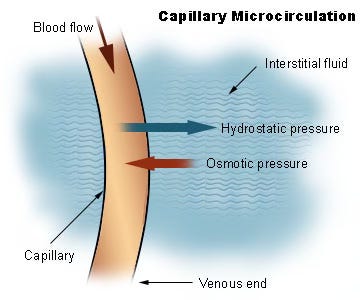Blood Cleansing
The last post discussed the importance of the capillary exchange of nutrients and wastes at a cellular level. There is another system involved in this exchange.
Blood from the capillaries does not come in actual contact with the cells of the human body. Components of the blood make the cellular exchange through a substance called Interstitial fluid (which can be simply called tissue fluid).
What Is Interstitial Fluid?
IF is a substance found in the spaces between tissue that is similar to blood plasma;
IF communicates with blood plasma;
The human body has about 2.9 gallons of IF;
The superpowers of IF include the ability to
Feed nutrients and chemicals from the blood to the cells;
Remove toxins from the cells; and
Communicate with cells.
The contents of IF can fluctuate depending on surrounding tissue, but the substance is generally composed of
water
amino acids
sugars
fatty acids
coenzymes
hormones
neurotransmitters
salts (minerals)
cellular waste
lymphocytes (white blood cells)
lymph
Relationship With Capillaries As discussed in Principle #2: Blood Circulation, capillaries are so small that blood cells can only enter one cell at a time. These same capillaries will not allow red blood cells, platelets, or plasma protein to pass through their walls, but they do allow the other substances in the blood (see Principle #1: Blood Quality) to pass into the interstitial fluid. This is the process that allows the capillary to make the cellular exchange. An osmotic process (osmosis) pushes these exchanged elements from the (arterial end) capillaries into the interstitial fluid and then back into the (venous end) capillaries returning to the heart (see image).
Relationship With The Lymphatic System
In order to prevent a build up of interstitial fluid, which can cause swelling (particularly of the ankles), the lymphatic system can absorb a portion of the fluid and transport it back into the blood.
The Cellular Wastes
Through the processes of osmosis and lymphatic exchange, cellular wastes are forced into the blood stream. From there the cellular wastes are transported to four elimination stations.
Four Elimination Stations
God has designed the human body to eliminate waste in four primary methods.
Lungs
Skin
Kidneys
Colon
We will discuss these elimination organs in much greater detail in the future. For now, let us say, that if the body cannot properly eliminate cellular wastes, they will build up in the body and cause disease and all kinds of health related problems.
Conclusion
Not only do we need to nourish every cell with the proper nutrients, but every cell needs to be cleansed of toxins as well.
Blood quality, blood circulation, and blood cleansing work together
To provide a healthy immune system
To provide proper nutrients to our cells
To cleanse the cells and tissues of our body
If one of the Life Principle elements are out of balance or not working properly, some tissue, organ, or part of our body will start to malfunction (beginning slowly at the cellular level) and symptoms of poor health will start to appear. Each of these three Principles must be operating properly in order to have a healthy body.
So, how do we maintain the proper blood quality, blood circulation, and blood cleansing so that our bodies will function according to God's intended fullness?
By Living Under God's Design
Next: 7 Biblical Principles For Living Under God's Design: Introduction
Return To: Biblical Health Study
--- --- --- ---
Most research for the interstitial fluid and lymphatic system, etc. was done on Wikipedia



